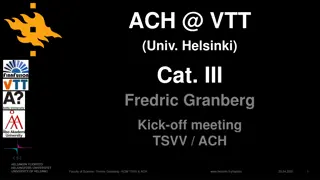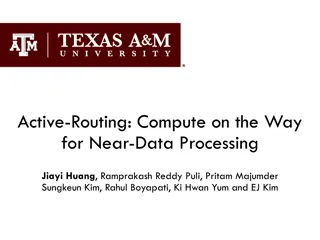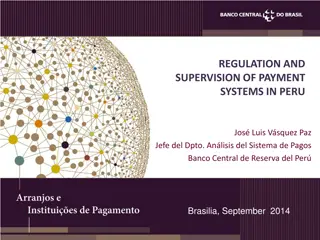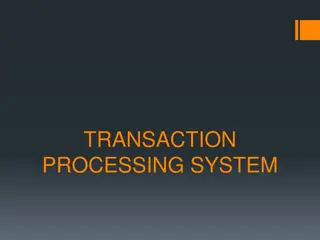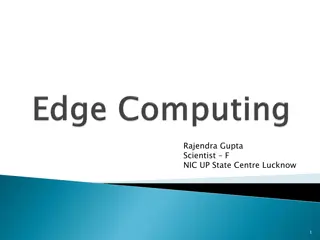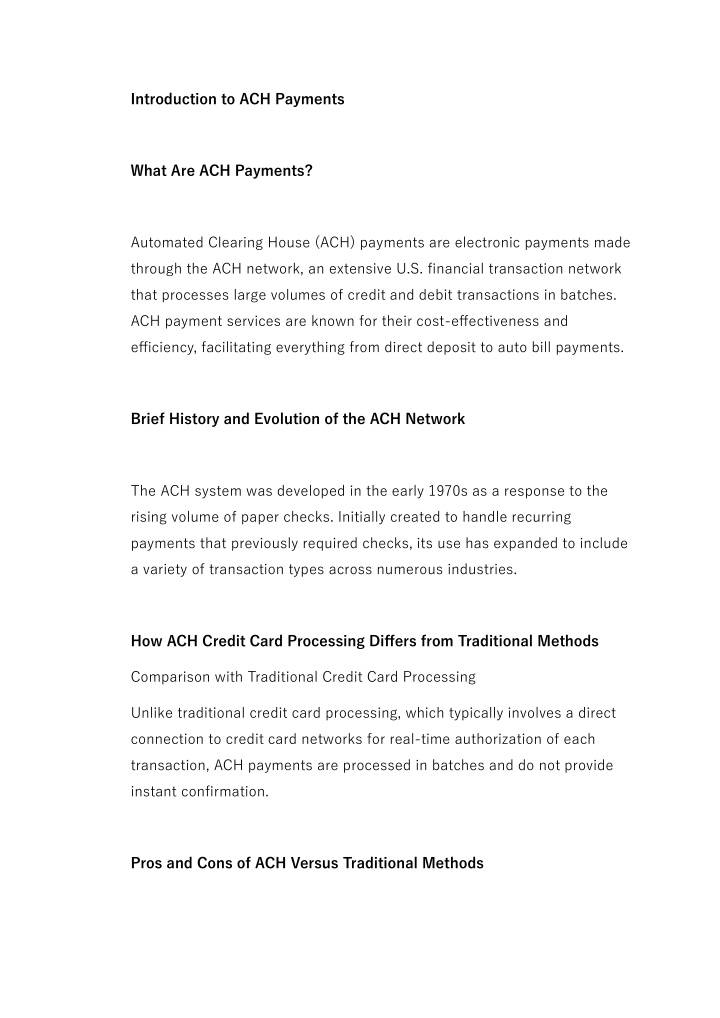
What is ACH Processing and how does it work?
Automated Clearing House (ACH) payments are electronic payments made through the ACH network, an extensive U.S. financial transaction network that processes large volumes of credit and debit transactions in batches. ACH payment services are known for their cost-effectiveness and efficiency, facilitating everything from direct deposit to auto bill payments.
Download Presentation

Please find below an Image/Link to download the presentation.
The content on the website is provided AS IS for your information and personal use only. It may not be sold, licensed, or shared on other websites without obtaining consent from the author. If you encounter any issues during the download, it is possible that the publisher has removed the file from their server.
You are allowed to download the files provided on this website for personal or commercial use, subject to the condition that they are used lawfully. All files are the property of their respective owners.
The content on the website is provided AS IS for your information and personal use only. It may not be sold, licensed, or shared on other websites without obtaining consent from the author.
E N D
Presentation Transcript
Introduction to ACH Payments What Are ACH Payments? Automated Clearing House (ACH) payments are electronic payments made through the ACH network, an extensive U.S. financial transaction network that processes large volumes of credit and debit transactions in batches. ACH payment services are known for their cost-effectiveness and efficiency, facilitating everything from direct deposit to auto bill payments. Brief History and Evolution of the ACH Network The ACH system was developed in the early 1970s as a response to the rising volume of paper checks. Initially created to handle recurring payments that previously required checks, its use has expanded to include a variety of transaction types across numerous industries. How ACH Credit Card Processing Differs from Traditional Methods Comparison with Traditional Credit Card Processing Unlike traditional credit card processing, which typically involves a direct connection to credit card networks for real-time authorization of each transaction, ACH payments are processed in batches and do not provide instant confirmation. Pros and Cons of ACH Versus Traditional Methods
Pros: Lower processing fees compared to credit cards Reduced risk of chargebacks Suitable for large transaction volumes Cons: Slower processing times, which can impact when funds are available Less suitable for point-of-sale purchases where immediate authorization is needed Technical Overview of ACH Processing How ACH Transactions Are Processed The ACH network requires multiple steps for transactions to be completed: Authorization: The customer must give permission for the originator to debit their bank account. Submission: The original sender provides their bank with the payment information. Batch Processing the Federal Reserve or The Clearing House, two ACH Operators, receive transactions from the bank in batches. Settlement: The originating and receiving banks complete the settlement of the funds. Roles of Different Entities Involved Originating Depository Financial Institution (ODFI): This is the first bank that requests the transfer of funds. Once bank process the request and credit account of recipients is known as Receiving Depository Financial Institution (RDFI).
ACH Operators: ACH Operators are the one that manage how financial institutions settle their transactions effectively. Benefits of Using ACH for Businesses and Consumers Cost-effectiveness: To be honest, the cost of ACH processing is less as compare credit card transaction fees. Security: illegal transaction can be reduced with the aid of improved fraud detection systems. Efficiency: Automating the recurring payment process reduces errors and saves time. Common Uses of ACH Payments Direct Deposits: Deposits are frequently used for things like tax refunds, government benefits, and payroll. Direct Deposits: Here deposits are used things like tax refunds, government benefits, and payroll. Bills paid by consumers: insurance payments, home loans, and utility bills Setting Up ACH Processing for Your Business Requirements Agreement with a financial institution or third-party processor that handles ACH transactions. Compliance with NACHA (The National Automated Clearing House Association) operating rules. Choosing the Right Bank or Payment Processor
There are certain things that you need to consider while choosing the payment processor like fees, customer service, technical support, Regulatory and Compliance Aspects Key Regulatory Bodies NACHA: Manages the development, administration, and governance of the ACH Network. Federal Reserve: Regulates and oversees the financial institutions involved in ACH transactions. Future of ACH Payments Emerging Technologies: Maintaining Security and transparency need to integrate blockchain. Adoption of same-day and real-time ACH processing to speed up transactions. Challenges and Considerations Processing Delays: Strategies to minimize impact, such as scheduling payments in advance. Compliance: Keeping up with changing regulations to avoid penalties. Conclusion and Next Steps Need to recap the things that we have discussed the above. Now it clear shows that how ACH processing is an important for your business operations. Whenever you are considering ACH processing, evaluate the business needs, potential benefits, and the suitability of your partners. If you are looking for merchant services in California, then you are at the right place.











